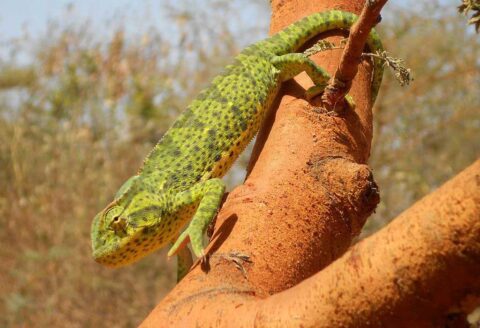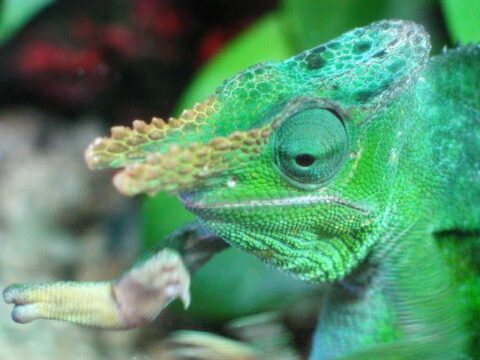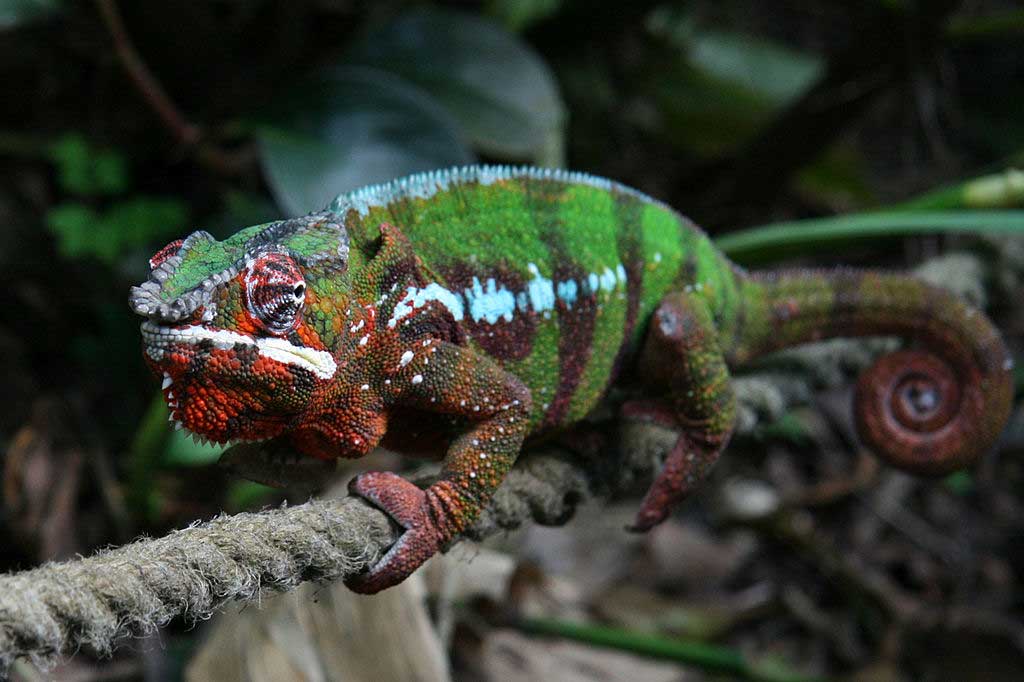
Content |
|---|
What do chameleons look like??
The Chameleons belong to reptiles (crawlers) and they look like lizards: Have an elongated body, four legs and a long tail.
The smallest species only measure three and a half centimeters, the largest reach a meter.
Attention is drawn to the crest of the back and the protrusion in the form of a head helmet.
Some even have small horns in their nose..
His eyes are unmistakable: they are big, protrude from the head like small balls and can move independently in different directions. With them, some species can see clearly up to a kilometer away.
As the top layer of scaly skin is hard, can't grow. So, chameleons have to shed their skin regularly. To make it easier to shed your old skin, animals are often rubbed against branches or stones.
The Chameleons are perfectly adapted to living in trees.
They can grip well even in windy conditions because their hands and feet have been transformed into real tweezers.:
The toes and fingers are fused two by two and three by three.
The bunch with all three toes or fingers points inward, the two points outward.
The tail also serves to hold: can wrap the branches and additionally secure the animal.
That is why it is also especially stable and cannot break and grow back as in other lizards..
Males and females are distinguished by the heel spur: it is a process on the back of the leg that only males have.
One of Madagascar's best-known chameleons, for example, is the Panther chameleon (Furcifer pardalis).
Males come to measure between 40 and 52 centimeters, the females up 30 centimeters.
Depending on the area of origin, have very different colors.
Males are green to turquoise in color and have light stripes, sometimes red, on the sides of the body. Females are usually more discreet.
Although the Panther chameleon originally found only in Madagascar, it was also introduced by man to the islands of Mauritius and Reunion, located east of Madagascar in the Indian Ocean.
Where do chameleons live??
The Chameleons they are only found in the so-called Old World, that is to say, in Africa, Southern Europe and South and Southwest Asia.
Chameleons are arboreal: they stay mainly in the branches of trees and shrubs, sometimes also in the low weeds.
Species that live in regions where there are few plants are adapted to living in the soil.
What species of chameleons exist?
There are some 70 chameleon species. On the island of Madagascar, off the coast of southeast Africa, lives a particularly large number of different species.
How many years do chameleons live?
In a terrarium, chameleons live four to five years. It is not known how many years they live in the wild.
What does a chameleon eat??
The Chameleons they feed mainly on insects.
His favorite food is grasshoppers, but also other insects and small lizards.
in the terrarium, feed them with insects, meal worms, caterpillars and earthworms. Larger chameleons even eat young mice.
Wild chameleons get water by licking leaf spray in the morning.
Chameleons in captivity
The terrarium
One of the most common chameleons in terrariums is the Chameleon of Yemen. It comes from a high valley (until 2.000 m) from Yemen, in the south of the Arabian Peninsula, where it lives in shrubs and trees.
The Chameleon from Yemen come to measure some 60 centimeters, females only a little more than 40 centimeters. But, animals kept in terrariums remain smaller.
The Panther chameleon it is also usually held in terrariums. Comes from the tropical island of Madagascar, where there are dry seasons every year. Thus, this species tolerates better than others fluctuations in temperature and humidity in the terrarium.
But like the Chameleons they are quite demanding solitaires, they are not animals suitable for pampering. It's best to keep them alone.
Males don't get along with each other at all, rather you can put two females together in a very large terrarium.
The Chameleons need a lot of space. The terrarium must be one meter long, one meter wide, at least 50 centimeters deep and, above all, high altitude, as chameleons like to climb.
The enclosure should be provided with many branches and plants. Normal sand is suitable as soil.
The Chameleons need heat: the temperature must be 25 at 32° C, and at night of 15 at 18° C. A special lamp in the terrarium provides the necessary heat.
Chameleon Care Plan
Water should be sprayed into the terrarium once a day to keep the humidity high enough.
The Chameleons they should only be fed every two or four days. Receive crickets, flies, grasshoppers and occasional mealworms. Before feeding them, insects are sprinkled with a mixture of vitamins and minerals.
To drink, chameleons lick plant water or give it to them on a shallow plate.
How does a chameleon live??
The Chameleons they are solitary animals and live in trees because there they can camouflage themselves especially well. But, predators, such as snakes or birds of prey, they cannot be chased away by the play of colors. And chameleons can't run away quickly either.. Avoid attacks by camouflaging themselves: with its spasmodic gait, imitate leaves that move back and forth in the wind. This makes animals appear much clumsier than they are.: Chameleons make excellent climbers. They roll up their long prehensile tail, that is normally coiled into your body, around the branches; this gives them additional support.
With your climbing toes, cling to branches like tweezers. But, these lizards fall off the tree from time to time, but they do it on purpose: if an enemy gets too close, the dead are made and dropped. No harm is done in the process: inflate their huge lungs and thus cushion the fall, as if they had tied a thick pillow.
How do chameleons reproduce??
The Chameleons they are also quarrelsome loners in the mating season. This occurs when several males fight fiercely for a female.; but males and females also quarrel with each other, sometimes even during mating.
The females of chameleon put between 30 and 40 eggs. They have a soft, apergaminated shell and bury themselves in the hot earth.
After a few months – this varies by species and habitat- the young hatch.
They are immediately independent and hunt small insects. Some species of chameleons give birth to live young: here the eggs develop in the womb of the female of the chameleon.
To prevent too many from living Chameleons in the same area, the young quickly go out on their own and search for their own territory.
The young do not yet have a color as defined as that of their parents, but when they turn one they are already adults and can have their own offspring.
How do chameleons hunt?
Chameleons usually sit quietly on a branch and be on the lookout for their prey.. If an insect gets close enough, catches him in an instant with his long tongue.
It is thickened like a club at the end and has two leaf-shaped lobes with which the prey is grasped..
This so-called tongue shot is so fast that it is almost invisible..
What's so special about chameleons??
When the Chameleons males are “Lovers”, are more colorful. Try to impress the ladies with this colorful show. In general, change color depending on your mood, and that in a few minutes. It's as if animals talk to each other in this way..
If they are afraid, for example during a fight over a female, many species change to black. This points to the rival: My opponent feels inferior and prefers not to fight. If, on the other hand, lizards are eager to attack, turn red. This then means something like: “Get lost or you'll get it!!”. It also, animals change their skin tone based on temperature and time of day.
In the morning, adopt darker shades to warm up, because dark colors absorb more light and skin, Therefore, absorbs more heat. After a long, hot day, animals are rinsed to cool off.
For a long time it was a mystery how the Chameleons change color so quickly. Scientists discovered it just a few months ago: Tiny blocks of glass in the skin of lizards are responsible for the chromatic frenzy. When light hits these blocks, reflect it in color.
The fact that the color changes is due to the fact that the distances between the crystals change according to the mood of the chameleon. Yes a Panther chameleon (Furcifer pardalis), is relaxed, for example, the blocks are close together and glow blue. When the animal is excited, separate and glow red.
List of chameleons for maintenance in captivity
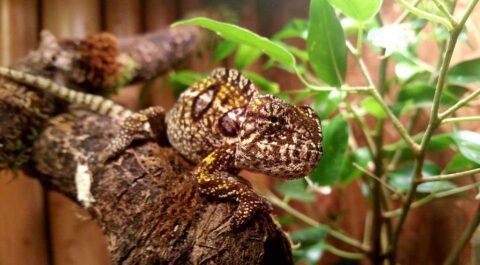
Carpet chameleon
The Carpet chameleon, formerly known as Chamaeleo lateralis, is a beautiful species in high demand for the pet trade ...
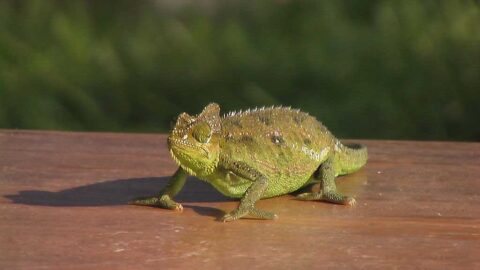
Von Höhnel's chameleon
The Von Höhnel's chameleon (Trioceros hoehnelii) is a high-altitude species that ascends to more than 3.000 m in ...
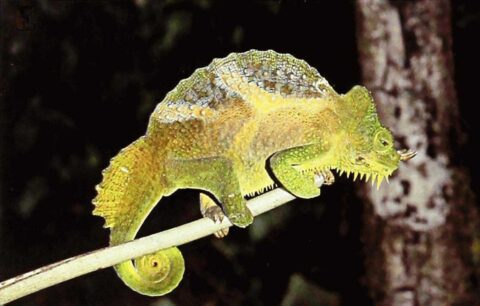
Four-horned chameleon
The Four-horned chameleon, also known as Cameroon bearded chameleon, it is recognizable not only by its four horns ...
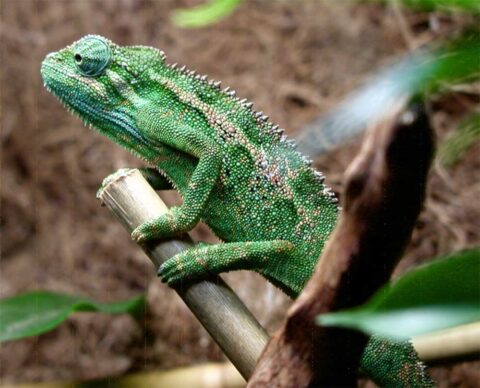
Montane side-striped chameleon
The Montane side-striped chameleon (Trioceros ellioti) has a soft personality. Although no chameleon should be considered as a pet for ...
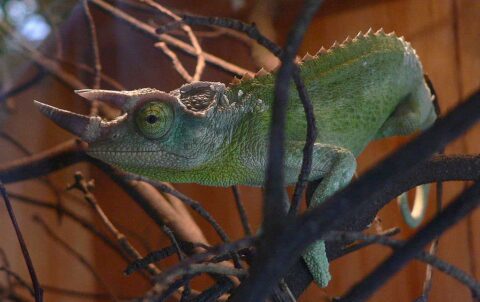
Jackson's chameleon
The Jackson's chameleon is diurnal and displays foraging behavior with few movements per minute and ...

Meller's chameleon
The Meller's chameleon It is the largest chameleon on the African continent., large males usually reach 61 ...
